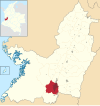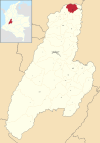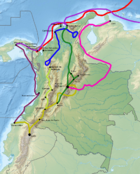Baltasar Maldonado
Baltasar Maldonado | |
|---|---|
| Born | c. 1510 |
| Died | 1552 (aged 41–42) |
| Nationality | Castilian |
| Occupations | Conquistador |
| Years active | 1536-1552 |
| Known for | Spanish conquest of the Muisca Defeat of Tundama Quest for El Dorado |
| Spouse | Leonor de Carvajal y Mendoza |
| Children | 4 |
| Parent |
|
| Relatives | Jorge Robledo (brother-in-law) |
Baltasar Maldonado, also written as Baltazar Maldonado,
In 1539, Maldonado defeated the last ruling Cacique (chieftain) of the Muisca, Saymoso (called "Tundama" by the Spaniards). Maldonado took part in a quest for El Dorado led by Hernán Pérez de Quesada in the southern regions of present-day Colombia. After this failed expedition, Maldonado went to Popayán and Cali and traveled back to Santafé de Bogotá, the capital of the New Kingdom of Granada where he died in 1552.[2]
The adventures of Maldonado during the first half of the 16th century have been described by
Early life
Maldonado was born in
Spanish conquest


In 1535, Maldonado traveled from Spain to Santo Domingo and then to Santa Marta.,[4] accompanying Santa Marta's interim governor, Rodrigo Infante. The army of the new governor, Pedro Fernández de Lugo, arrived on January 2, 1536, and punitive expeditions against the rebel natives of the area were conducted. Maldonado then joined the expedition led by Fernandez's de Lugo lieutenant, Gonzalo Jiménez de Quesada, whose purpose was to explore the Magdalena River and to find a land path to Peru. The expedition discovered toward the Eastern Ranges where later they encountered two other expeditions: an eastern expedition led by Nikolaus Federmann, and another one led by Sebastián de Belalcázar. Immediately after Bogotá was established (August 6, 1538), the soldiers participated in the Battle of Tocarema in late August to over-power the Panche who lived to the west of the Altiplano Cundiboyacense.
Conquest of Tundama

The Muisca Confederation was separated into federations: The
Maldonado defeated Tundama and 4000 other Muisca in a December 1539 battle, a struggle that took two weeks, culminating in the Battle of Vargas Swamp, close to Paipa, where 280 years later the famous Battle of Vargas Swamp by Simón Bolívar would be fought.[8][9][10] Tundama was killed by Maldonado wielding a large hammer.[8]
Quest for El Dorado

The
The conquistadors passed the mountains of the Eastern Ranges and crossed the
Maldonado walked for three days, finally encountering a lush valley in
The expedition to find El Dorado had failed because many of the Spanish soldiers died of diseases, poisoned arrows, and drowning in the numerous rivers of the
Later life and death
Maldonado, who had spent years in the conquest of Colombian terrain, returned to Bogotá via Pensilvania.[6] He died in the capital in 1552.[2]
Maldonado's expeditions of conquest
| Name | Department | Date | Year | Notes | Map |
|---|---|---|---|---|---|
| Quito | Pichincha | 6 December | 1534 | [2] |  |
Cali (1)
|
Valle del Cauca | 1536 |  | ||
| Popayán (1) | Cauca | 1537 |  | ||
Falán
|
Tolima | 1539 | [11] |  | |
| Mariquita | Tolima | 1539 | [12] |  | |
| Manzanares | Caldas | 1539 | [1][13] |  | |
| Marquetalia | Caldas | 1539 | [1] |  | |
| Duitama | Boyacá | 15 December | 1539 | [8] |  |
| Pasca | Cundinamarca | Early September | 1540 | [5] |  |
| Nevado del Sumapaz | Cundinamarca | 1540 |  | ||
| San Martín | Meta | 1540 | [14] |  | |
| Florencia | Caquetá | 1540 | [15] |  | |
San José de la Fragua
|
Caquetá | 1540 | [5] |  | |
| Mocoa | Putumayo | 1540-41 | [5] |  | |
| Sibundoy | Putumayo | 1541 | [5] |  | |
| Popayán (2) | Cauca | 1541 | [5] |  | |
Cali (2)
|
Valle del Cauca | 1541 | [6] |  | |
| Pensilvania | Caldas | 1541-1550 | [16] |  |
The Maldonado family

The Maldonado family lived in Salamanca, Spain. Notable is Francisco Maldonado, who was a leader in the Revolt of the Comuneros. Various conquistadors and other people involved in the Spanish colonization of the Americas from the Maldonado family are known in history.[17][18][19][20][21][22][23][24]
- Bituima, Diego Carasquilla Maldonado — became an oídor for Santa Fe de Bogotá in Lima;
- (Francisco) Arias Maldonado — who also served under De Belálcazar and became encomendero of Sora in Boyacá;
- Francisco de Grado Maldonado – son of Isabel Maldonado, was a conquistador in Peru.
- Francisco Maldonado Dorado del Hierro — served under German conquistadors Georg von Speyer and Nikolaus Federmann, and was later made encomendero of Sasaima; and
- Isabel Maldonado, married to two conquistadors: Pedro Núñez Cabrera and, following his death, Miguel Holguín y Figueroa.[25]
- Juan Maldonado — another conquistador in Colombia and son-in-law of Ortún Velázquez de Velasco;
- Juan Prieto Maldonado — conquistador in Tunja;
- Rodrigo Arias de Maldonado — conquistador in New Spain;
See also
References
- ^ a b c (in Spanish) Despoblamiento y repoblamiento del noroccidente – Banco de la República
- ^ a b c d (in Spanish) Biography Baltasar Maldonado – Soledad Acosta Samper – Banco de la República
- ^ a b Baltasar Maldonado – Geni
- ^ a b c d e Rodríguez Freyle, 1638, p.88
- ^ a b c d e f g h i Rodríguez Freyle, 1638, p.93
- ^ a b c Rodríguez Freyle, 1638, p.94
- ^ Rodríguez Freyle, 1638, p.52
- ^ a b c d e (in Spanish) Biography Cacique Tundama - Pueblos Originarios
- ^ a b (in Spanish) Biography Tundama Archived 2017-09-21 at the Wayback Machine
- ^ (in Spanish) Battle of Vargas Swamp, 1819
- ^ (in Spanish) Official website Falán[permanent dead link]
- ^ (in Spanish) Mariquita - los primeros pobladores
- ^ (in Spanish) Official website Manzanares
- ^ (in Spanish) Official website San Martín
- ^ (in Spanish) Official website Florencia Archived 2016-05-03 at the Wayback Machine
- ^ (in Spanish) Official website Pensilvania
- ^ (in Spanish) Arias de Maldonado – Soledad Acosta Samper – Banco de la República
- ^ (in Spanish) Francisco Maldonado Dorado del Hierro – Banco de la República – Soledad Acosta Samper
- ^ Rodríguez Freyle, 1638, p.126
- ^ Rodríguez Freyle, 1638, p.182
- ^ Rodríguez Freyle, 1638, p.183
- ^ Rodríguez Freyle, 1638, p.260
- ^ Rodríguez Freyle, 1638, p.415
- ^ (in Spanish) List of conquistadors led by Gonzalo Jiménez de Quesada – Banco de la República
- ^ Rodríguez Freyle, 1638, p.153
Bibliography
- Rodríguez Freyle, Juan, and Darío Achury Valenzuela. 1979 (1859) (1638). El Carnero - Conquista i descubrimiento del nuevo reino de Granada de las Indias Occidentales del mar oceano, i fundacion de la ciudad de Santa Fe de Bogota, 1-598. Fundacion Biblioteca Ayacuch. Accessed 2016-11-21.
Further reading
- Acosta, Joaquín. 1848. Compendio histórico del descubrimiento y colonización de la Nueva Granada en el siglo décimo sexto – Historical overview of discovery and colonization of New Granada in the sixteenth century, 1-460. Beau Press. Accessed 2017-03-01.
- De Castellanos, Juan. 1857 (1589). Elegías de varones ilustres de Indias, 1–567. Accessed 2017-03-01.
- Fernández de Piedrahita, Lucas. 1676. VI. Historia general de las conquistas del Nuevo Reino de Granada. Accessed 2017-03-01.
- Jiménez de Quesada, Gonzalo. 1576. Memoria de los descubridores, que entraron conmigo a descubrir y conquistar el Reino de Granada. Accessed 2017-03-01.
- Ocampo López, Javier. 1996. Leyendas populares colombianas - Popular Colombian legends, 1-384. Plaza y Janes Editores. Accessed 2017-03-01.
- De Plaza, José Antonio. 1810. Memorias para la historia de la Nueva Granada desde su descubrimiento el 20 de julio de 1810, 1-464. Imprenta del Neo-Granadino. Accessed 2017-03-01.
- Simón, Pedro. 1892 (1626). Noticias historiales de las conquistas de Tierra Firme en las Indias occidentales (1882-92) vol.1-5. Accessed 2017-03-01.
- N, N. 1979 (1889) (1539). Epítome de la conquista del Nuevo Reino de Granada, 81-97. Banco de la República. Accessed 2017-03-01.
External links
- (in Spanish) The conquest of Tundama

